Maggie Secara's Blog, page 5
November 1, 2013
Shawna Reppert: The Power of Death and Rebirth

I want to make up for leaving this space empty for two weeks while I gallivanted about England, and Shawna Reppert hasd kindly consented to help. We talked with Shawna back in May about her novel The Stolen Luck. This time, psychopomp, she guides us on a trip in quite another direction, into the mysteries and conventions of death, and the return therefrom.

The year died yesterday. At least, it did on the Celtic calendar where the festival of Samhain (later Christianized to All Hallow’s Eve, or Hallowe’en) marks the end of the old year. In Mexico, today is the start of Dia de los Muertos, when the memories of loved ones are honored and spirits are said to walk the Earth. It’s a good time to think about the power of the death/rebirth cycle in fiction, one of the most powerful tools in a writer’s toolbox.
The death can be literal— Buffy in Buffy the Vampire Slayer, Wesley in The Princess Bride. It can be a ‘near-death’ experience where a character faces great peril and is believed by other characters to be dead— Gandalf in The Lord of the Rings, Sherlock Holmes in His Last Bow. (Though the latter is a special case as Doyle claims to have originally intended to leave the detective dead.) It can even be a symbolic death where the character loses everything he holds dear and comes through the experience transformed for good or ill. Loki in the first Thor movie discovered that everything that he thought he knew about his identity was wrong, and as a result becomes the very worst of what people expected of him. Even Scrooge’s brush with the afterlife in the visitation by ghosts and witnessing his own future grave and the subsequent transformation could be considered a symbolic death and rebirth.
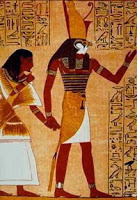
On a simple level, the death/rebirth sequence is a catalyst for the character to change. And really, that’s what fiction is all about. Who wants to read a story where nothing happens? Having a character die (or almost-die) is a great way to raise the stakes, increasing tension. It also plays with a reader’s emotions, taking them from the depths of despair when they think the hero is dead to the heights of joy when the hero returns. To make it work, the danger needs to feel real. It’s stronger if the resurrection comes at a cost.
The tenth Doctor’s regeneration in the long-running BBC TV series Doctor Who carried more impact than any of his predecessors because he raged so hard against it. The earlier Doctors seemed to accept regeneration as at worst an annoyance. David Tennant’s Doctor makes it clear that he considers regeneration as a form of personal death, even though his mind and memories will continue in a new body.
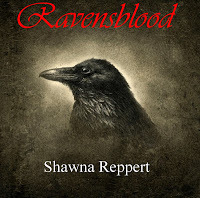
In my urban fantasy Ravensblood, the first death/rebirth sequence comes relatively early in the novel, when Raven’s long-buried conscience will no longer allow him to serve William Blanchard, a dark mage who would overthrow the elected government and set up his own rule by power and fear. Raven survives, but he still suffers from the attempt. The new role into which he is metaphorically reborn— that of spy in William’s camp— comes with the threat of a death far more gruesome than the one he would have chosen for himself.
When a writer uses the death/rebirth sequence, they tap into powerful resonances, from the Stag God who is hunter and hunted and feeds the people with his death, to Osiris murdered and dismembered by Set and reassembled and resurrected by his wife, to Odin hanging on the World Tree, and Christ dying on the cross and rising again. It is the cycle of nature, the reality of our existence, the grain that is reaped in autumn and rises again as green shoots in spring. Readers may or may not consciously recognize the reference, but on a subconscious level it strikes a powerful cord. The death and rebirth cycle joins modern fiction with the power of myths older than time.
 More about
Ravensblood
In a life of impossible choices when sometimes death magic is the lesser of the evils, can a dark mage save the world and his own soul?
More about
Ravensblood
In a life of impossible choices when sometimes death magic is the lesser of the evils, can a dark mage save the world and his own soul? Corwyn Ravenscroft. Raven. The last heir of an ancient family of dark mages, he holds the secret to recreating the Ravensblood, a legendary magical artifact of immense power.
Cassandra Greensdowne is a Guardian. Magical law enforcement for the elected council— and Raven’s former apprentice and lover. She is trying to live down her past. And then her past comes to the door, asking for her help.
As a youth, Raven wanted to be a Guardian but was rejected because of his ancestry. In his pride and his anger, he had turned to William, the darkest and most powerful mage of their time. William wants a return to the old ways, where the most powerful mage was ruler absolute. But William would not be a True King from the fairy tales. He would reign in blood and terror and darkest magic.
Raven discovers that he does have a conscience. It’s rather inconvenient. He becomes a spy for the council that William wants to overthrow, with Cassandra as his contact. Cass and Raven have a plan to trap William outside his warded sanctuary. But William is one step ahead of the game, with Raven’s life, his soul, and the Ravensblood all in danger.
Ravensblood is available here!

More about Shawna ReppertFrom earliest childhood, Shawna Reppert has had a passion for stories – for reading them and for writing them. She obtained a BA in English with a Writing Option from Penn State University and has participated in numerous writing workshops and seminars given by the likes of Charles de Lint, David Farland and Elizabeth Lyon. Two of her stories have won honorable mentions from Writers of the Future. Previous short stories sold to "10 Flash Quarterly" and to "Everyday Fiction". Several ‘indie’ short stories are available for sale at Amazon, and her story ‘The Beast Within’ appears in the steampunk anthology Gears and Levers 2 edited by Phyllis Irene Radford. Her first novel The Stolen Luck came out as a Carina Press e-book in May 2013 and is also available in Audible format.
In college, Shawna volunteered at a raptor rehabilitation center, which became valuable background for her short story "The Sword and the Kestrel". Shawna has always had an affinity for wolves, and used to keep a wolf-dog hybrid as a pet, giving her first-hand experience to put the wolf in her werewolves. Her current four-footed children are a Lipizzan stallion and an orange-and-black cat named Samhain. She enjoys Irish social dancing and is an ardent supporter of live Irish music. Shawna also likes to play with the Society for Creative Anachronism and can sometimes be found in medieval garb on a caparisoned horse, throwing javelins into innocent hay bales that never did anything to her.
A Pennsylvania native, she currently lives in the beautiful wine county of Oregon.
Published on November 01, 2013 06:00
Shawnna Reppert: The Power of Death and Rebirth

I want to make up for leaving this space empty for two weeks while I gallivanted about England, and Shawnna Reppert hasd kindly consented to help. We talked with Shawnna back in May about her novel The Stolen Luck. This time, psychopomp, she guides us on a trip in quite another direction, into the mysteries and conventions of death, and the return therefrom.

The year died yesterday. At least, it did on the Celtic calendar where the festival of Samhain (later Christianized to All Hallow’s Eve, or Hallowe’en) marks the end of the old year. In Mexico, today is the start of Dia de los Muertos, when the memories of loved ones are honored and spirits are said to walk the Earth. It’s a good time to think about the power of the death/rebirth cycle in fiction, one of the most powerful tools in a writer’s toolbox.
The death can be literal— Buffy in Buffy the Vampire Slayer, Wesley in The Princess Bride. It can be a ‘near-death’ experience where a character faces great peril and is believed by other characters to be dead— Gandalf in The Lord of the Rings, Sherlock Holmes in His Last Bow. (Though the latter is a special case as Doyle claims to have originally intended to leave the detective dead.) It can even be a symbolic death where the character loses everything he holds dear and comes through the experience transformed for good or ill. Loki in the first Thor movie discovered that everything that he thought he knew about his identity was wrong, and as a result becomes the very worst of what people expected of him. Even Scrooge’s brush with the afterlife in the visitation by ghosts and witnessing his own future grave and the subsequent transformation could be considered a symbolic death and rebirth.

On a simple level, the death/rebirth sequence is a catalyst for the character to change. And really, that’s what fiction is all about. Who wants to read a story where nothing happens? Having a character die (or almost-die) is a great way to raise the stakes, increasing tension. It also plays with a reader’s emotions, taking them from the depths of despair when they think the hero is dead to the heights of joy when the hero returns. To make it work, the danger needs to feel real. It’s stronger if the resurrection comes at a cost.
The tenth Doctor’s regeneration in the long-running BBC TV series Doctor Who carried more impact than any of his predecessors because he raged so hard against it. The earlier Doctors seemed to accept regeneration as at worst an annoyance. David Tennant’s Doctor makes it clear that he considers regeneration as a form of personal death, even though his mind and memories will continue in a new body.

In my urban fantasy Ravensblood, the first death/rebirth sequence comes relatively early in the novel, when Raven’s long-buried conscience will no longer allow him to serve William Blanchard, a dark mage who would overthrow the elected government and set up his own rule by power and fear. Raven survives, but he still suffers from the attempt. The new role into which he is metaphorically reborn— that of spy in William’s camp— comes with the threat of a death far more gruesome than the one he would have chosen for himself.
When a writer uses the death/rebirth sequence, they tap into powerful resonances, from the Stag God who is hunter and hunted and feeds the people with his death, to Osiris murdered and dismembered by Set and reassembled and resurrected by his wife, to Odin hanging on the World Tree, and Christ dying on the cross and rising again. It is the cycle of nature, the reality of our existence, the grain that is reaped in autumn and rises again as green shoots in spring. Readers may or may not consciously recognize the reference, but on a subconscious level it strikes a powerful cord. The death and rebirth cycle joins modern fiction with the power of myths older than time.
 More about
Ravensblood
In a life of impossible choices when sometimes death magic is the lesser of the evils, can a dark mage save the world and his own soul?
More about
Ravensblood
In a life of impossible choices when sometimes death magic is the lesser of the evils, can a dark mage save the world and his own soul? Corwyn Ravenscroft. Raven. The last heir of an ancient family of dark mages, he holds the secret to recreating the Ravensblood, a legendary magical artifact of immense power.
Cassandra Greensdowne is a Guardian. Magical law enforcement for the elected council— and Raven’s former apprentice and lover. She is trying to live down her past. And then her past comes to the door, asking for her help.
As a youth, Raven wanted to be a Guardian but was rejected because of his ancestry. In his pride and his anger, he had turned to William, the darkest and most powerful mage of their time. William wants a return to the old ways, where the most powerful mage was ruler absolute. But William would not be a True King from the fairy tales. He would reign in blood and terror and darkest magic.
Raven discovers that he does have a conscience. It’s rather inconvenient. He becomes a spy for the council that William wants to overthrow, with Cassandra as his contact. Cass and Raven have a plan to trap William outside his warded sanctuary. But William is one step ahead of the game, with Raven’s life, his soul, and the Ravensblood all in danger.
Ravensblood is available here!

More about Shawnna ReppertFrom earliest childhood, Shawna Reppert has had a passion for stories – for reading them and for writing them. She obtained a BA in English with a Writing Option from Penn State University and has participated in numerous writing workshops and seminars given by the likes of Charles de Lint, David Farland and Elizabeth Lyon. Two of her stories have won honorable mentions from Writers of the Future. Previous short stories sold to "10 Flash Quarterly" and to "Everyday Fiction". Several ‘indie’ short stories are available for sale at Amazon, and her story ‘The Beast Within’ appears in the steampunk anthology Gears and Levers 2 edited by Phyllis Irene Radford. Her first novel The Stolen Luck came out as a Carina Press e-book in May 2013 and is also available in Audible format.
In college, Shawna volunteered at a raptor rehabilitation center, which became valuable background for her short story "The Sword and the Kestrel". Shawna has always had an affinity for wolves, and used to keep a wolf-dog hybrid as a pet, giving her first-hand experience to put the wolf in her werewolves. Her current four-footed children are a Lipizzan stallion and an orange-and-black cat named Samhain. She enjoys Irish social dancing and is an ardent supporter of live Irish music. Shawna also likes to play with the Society for Creative Anachronism and can sometimes be found in medieval garb on a caparisoned horse, throwing javelins into innocent hay bales that never did anything to her.
A Pennsylvania native, she currently lives in the beautiful wine county of Oregon.
Published on November 01, 2013 06:00
October 30, 2013
Kiini Ibura Salaam : Making Space for the Work
 Another fabulous Broad Universe author, Kiini Ibura Salaam is a writer, painter, and traveler from New Orleans, Louisiana. Her first book of shhort stories,
Ancient, Ancient
, is the 2013 co-winner of the Tiptree Award. To read more of her thoughts on self-promotion, download her new ebook On the Struggle to Self-Promote. You can read more about writing at http://kiiniibura.com/category/blog/
Another fabulous Broad Universe author, Kiini Ibura Salaam is a writer, painter, and traveler from New Orleans, Louisiana. Her first book of shhort stories,
Ancient, Ancient
, is the 2013 co-winner of the Tiptree Award. To read more of her thoughts on self-promotion, download her new ebook On the Struggle to Self-Promote. You can read more about writing at http://kiiniibura.com/category/blog/
As a writer, I engage in a lot of self-reflection. I’m not talking about navel-gazing journeys into my soul (though I do that too)—I’m talking about problem solving. All writing requires problem solving from the perspective of craft, but there’s an added layer of problem solving needed
 to build a career as writer—and it has nothing to do with how well you develop your characters or complete your story arcs. The problem is—once you’ve beat back life’s responsibilities, cleared time and space to write, (temporarily) silenced your inner critic (who likes to drone on about why your literary pursuits are pointless), withstood peer critique, and created something you’re proud of—how the bleep do you make sure the world knows about it?
to build a career as writer—and it has nothing to do with how well you develop your characters or complete your story arcs. The problem is—once you’ve beat back life’s responsibilities, cleared time and space to write, (temporarily) silenced your inner critic (who likes to drone on about why your literary pursuits are pointless), withstood peer critique, and created something you’re proud of—how the bleep do you make sure the world knows about it?Throughout my twenty years as a writer, I have resented, feared, and avoided telling the world about my work. I’ve never been the dramatic or hyperbolic sort. I’ve always believed my work is valuable, yet I have consistently felt reluctant to “force” it on people. I preferred to believe that the work’s merit would bring it the attention it deserved. Here’s the thing: in the early years of my career, I had plenty of time to burn that fantasy, but now—two decades later—it has become crystal clear that if I don’t put my own promotional might behind my literary efforts, I may never become the writer I want to be. Overnight, it seems, a burning bush has sprung into my psyche, screeching its warnings that if I do not change my behavior today, I cannot transform the outcome of my tomorrow; that if I want to be a full time writer in the future, then today, I must announce and re-announce my work to the world as often as possible for as long as it takes.
 I say all this because I suspect many writers struggle with these same issues. We want to sit in our rooms and play with words. We want to dream new worlds and characters, and navigate new ideas. We want to write, dammit! We don’t want to call bookstores, write press releases, and email radio stations. So I’ve had to give the adult in me the permission to take over. She fired my emotions, drew up a self-promotion plan, and notified me that marketing myself is nonnegotiable. If I am going to write—and I am going to write—then I must also clear a space for that writing in the world. I’ve had no choice but to become my own personal town crier, shouting about my stories, my books, and my successes in the town square (read: Facebook, Twitter, blogs, conversations, conferences, and book fairs).
I say all this because I suspect many writers struggle with these same issues. We want to sit in our rooms and play with words. We want to dream new worlds and characters, and navigate new ideas. We want to write, dammit! We don’t want to call bookstores, write press releases, and email radio stations. So I’ve had to give the adult in me the permission to take over. She fired my emotions, drew up a self-promotion plan, and notified me that marketing myself is nonnegotiable. If I am going to write—and I am going to write—then I must also clear a space for that writing in the world. I’ve had no choice but to become my own personal town crier, shouting about my stories, my books, and my successes in the town square (read: Facebook, Twitter, blogs, conversations, conferences, and book fairs).Is it exhausting? Yes. Does it feel like I’m repeating myself and overstepping my bounds? Yes. Is it absolutely necessary? Yes, yes, and yes. My willingness to promote myself and my work is my willingness is taking a stand for my identity as a writer in word and deed. My ability to be a writer out loud in the world depends on my ability to tell the world—all day, every day—that I am a writer and I have work to share. Engaging in self-promotion requires me to constantly massage my anxieties and manage my personal hysterias. When I feel I am over-sharing about my work, I remember how excited and inspired I am to receive my peers’ announcements of their progress and achievements. When the feeling that I’m begging for attention or trying to convince someone of my merit starts pulling at me, I publicly acknowledge the discomfort of self-promotion then plow on sharing news of my work.
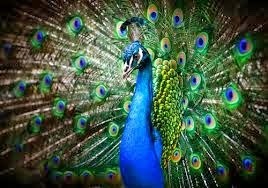
The difficulties of tooting your own horn do not disappear. They burrow away and silently morph into different modes of madness, popping up unexpectedly just when you think you’ve got this whole self-promotion thing under control. It’s a balancing act. I know that self-representation is a powerful act that can create ripples of success for me and inspiration for others. I know that going to my grave as a little known writer would not bother me half as much as going to my grave without having tried to secure a place for myself in the world’s literary imagination. After the quiet wrestling with words is complete, a writer’s work is not done. There are those other necessary acts required without which your creativity will not have a presence in the world.

More from Kiini Ibura SalaamAncient, Ancient: an award-winning collection of short stories.Buy it online (print or ebook): www.indiebound.org/book/9781933500966 or at Amazon.com
Connect with Kiini Ibura SalaamWebsite: www.kiiniibura.com
twitter: @kiiniibura
facebook: www.facebook.com/kiiniibura
video: http://www.youtube.com/watch?v=w4dBM14_uf0
Published on October 30, 2013 06:00
October 9, 2013
Dover Whitecliff: What if There's a Connection?
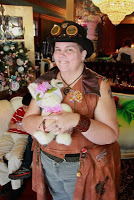 Dover Whitecliff was born in the shadow of Fujiyama, raised in the shadow of Olomana, and lives where she can see the shadow of Shasta if she squints and it's a really clear day. She's also a bit mad, as you might expect, growing up in all those shadows. Her first novel, The Stolen Songbird, is set in a Victorian Age that never was but could have been, and will be out later in 2013. (The jewels decorating the article below represent the elements as described therein.) I'll just let her carry on from here.
Dover Whitecliff was born in the shadow of Fujiyama, raised in the shadow of Olomana, and lives where she can see the shadow of Shasta if she squints and it's a really clear day. She's also a bit mad, as you might expect, growing up in all those shadows. Her first novel, The Stolen Songbird, is set in a Victorian Age that never was but could have been, and will be out later in 2013. (The jewels decorating the article below represent the elements as described therein.) I'll just let her carry on from here.

What and if are my two favorite words (after dragon and defenestration) and the question they ask together is the purpose of my existence as a writer. For me, writing is like breathing. I can’t not do it. I can’t not ask “what if…” Every writer in the history of storytelling knows something of what if. Otherwise, the tales we love would all be factual accounts of what was going on at the time. There would have been no Nautilus if Jules Verne had not inspired it. If Asimov had never written I, Robot, Honda's engineers might never have invented Asimo.
My first experience with the addictive nature of these two simple words was in eighth grade. My parents had a rule when I was growing up. I could read or watch anything of my own choosing for a price. For everything I chose, I would also have to read or watch something that they chose for me. For every issue of X-Men or Hardy Boys, I had to read a classic (thank you, mom and dad, for introducing me to Dumas and Pyle). For every Saturday morning cartoon or episode of Starsky and Hutch, I was plopped down to watch a documentary on any number of subjects from waterfowl to World War II.
 One of these ‘required’ shows was on public television, and was not in the least a chore, because it showed the chain of history in a way that I had never seen it before. For the first time, I didn’t pretend to take notes while actually scribbling stories. The pencil stayed motionless because I was entranced. I wanted to find out what happened next. That show was Connections with James Burke. In each episode, he looked at some simple item like the stirrups on a saddle, and showed how that invention connected to a chain of inventions that in turn led to something as massively life changing as global communication.
One of these ‘required’ shows was on public television, and was not in the least a chore, because it showed the chain of history in a way that I had never seen it before. For the first time, I didn’t pretend to take notes while actually scribbling stories. The pencil stayed motionless because I was entranced. I wanted to find out what happened next. That show was Connections with James Burke. In each episode, he looked at some simple item like the stirrups on a saddle, and showed how that invention connected to a chain of inventions that in turn led to something as massively life changing as global communication. In one episode, Mr. Burke is sitting in a dusty stone room in Egypt, wearing a linen suit, and casually telling the audience about the sacking of the Library of Alexandria. He then off-handedly mentions that all of our knowledge of Western Civilizatio--Plato, Pythagoras, all of the great things we know today--came from what was left of the basement of the library after it was burned. The basement.
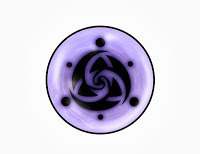 When I heard that, what and if reared their heads, and my brain whirred into overdrive. If all of that was in the basement, what was up above in the stacks? What if all of that stuff was in the basement because it was just junk and we’d based our whole civilization on it? What if everything we know is wrong? That one thought led to my first serious attempt at a fantasy novel and from that moment to this, I’ve never doubted the power or creativity of what and if together.
When I heard that, what and if reared their heads, and my brain whirred into overdrive. If all of that was in the basement, what was up above in the stacks? What if all of that stuff was in the basement because it was just junk and we’d based our whole civilization on it? What if everything we know is wrong? That one thought led to my first serious attempt at a fantasy novel and from that moment to this, I’ve never doubted the power or creativity of what and if together.
 Writing a story in a parallel or alternate history is one of the more challenging forms of what if, and requires you to think like Mr. Burke. Arguably, you still have to be consistent when creating a whole world from scratch, Tolkien being the consummate example of the consistent world-builder. However, with a home-grown world, the reader doesn’t have an idea of what your world looks like or what its rules are. This gives you more freedom in explaining those rules in the context of your story.
Writing a story in a parallel or alternate history is one of the more challenging forms of what if, and requires you to think like Mr. Burke. Arguably, you still have to be consistent when creating a whole world from scratch, Tolkien being the consummate example of the consistent world-builder. However, with a home-grown world, the reader doesn’t have an idea of what your world looks like or what its rules are. This gives you more freedom in explaining those rules in the context of your story.Alternatively, if your story is set on an earth where history has diverged at some point, you have to be more careful. Readers will bring their own knowledge of history along for the ride, and collaborating with that experience requires a bit more work on your part. Like James Burke, you then have to follow the connections for every point of divergence and look five or six or twenty turnings down the line to remain consistent.
 The Stolen Songbird, which will be out later this year, will be my first book, and it takes place in a Victorian Age that never was but should have been. In creating the world, my coauthor and I asked a lot of questions starting with what if. What if the Battle of Hastings was only a part of what really happened at Senlac Hill on October 14, 1066? What if Elizabeth I had left an heir, the first Victoria? What if Napoleon had a clockwork army? What if America were still a colony under Victoria III?
The Stolen Songbird, which will be out later this year, will be my first book, and it takes place in a Victorian Age that never was but should have been. In creating the world, my coauthor and I asked a lot of questions starting with what if. What if the Battle of Hastings was only a part of what really happened at Senlac Hill on October 14, 1066? What if Elizabeth I had left an heir, the first Victoria? What if Napoleon had a clockwork army? What if America were still a colony under Victoria III? Each of those changes in history required a lot of diagramming to plot out what events they would either cause or stop from happening. And if a change precluded something later in history that was necessary to the story, it required even more diagramming to bring about the required change. Each and every divergence in this history-as-you-may-not-know-it requires us to map out the connections, whether those facts ever make it into the book or not.
Knowing that what and if are out there and also in my soul is what gets me up in the morning. Because while dragon and defenestration may make for a great story, with what and if I can change the world.

Meet Dover WhitecliffDover Whitecliff is a wild and woolly wordsmith, a blogger, an analyst, and a jack-of-all-trades, but mostly a writer. She has been writing since the ripe old age of nine and won her first ten-speed as a fifth grader with an entry in the Honolulu Advertiser’s “Why Hawaii Isn't Big Enough For Litter” contest.
She currently spends her free time blogging or playing Rock Band with her husband, big brother, little brother, and consigliere, all of whom will graciously allow her to touch the instruments on occasion, but mostly just hand off the microphone so she can sing. She lives in Sacramento, California with her very patient and wonderful husband and several hundred bears.
Get to know Dover betterYou can find Dover:
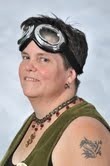
On Twitter (or @DoverWhitecliff)
And on Facebook
Or blogging at Wild and Woolly WordsmithOh, and she's working on the website, so don't look for her here... YET
http://www.departmentoffeyrelations.com/
Published on October 09, 2013 07:00
October 6, 2013
T.E. MacArthur: What about History?
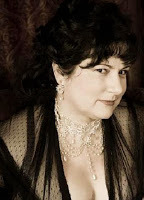
A little late this week? No, way late. Between trying to finish a submittable fdraft for Mermaid Stair, preparing for a trip to England, and trying to find a job, the week kind of got away from me. But he's the fabulous Thena MacArthur with a few strong opinions

When I first wrote this blog entry for Maggie, it was a 1,000 word rant about crappy historical fiction, namely the script of a TV series that butchered the character of a 19th Century woman I so greatly admire. I got on my high horse about accuracy with facts, not realizing that I was tilting windmills. The truth is, bodice ripper altered histories sell and sell big right now. And I blame Mr. Smith back at every high school in America for that.
Bear with me here, there’s some madness in my logic.

The ubiquitous Mr. Smith is your average public school history teacher who is fighting alarming trends in education, crappy pay, long hours, and a cultural malaise that can only deaden the heart of curiosity. Basically, across this country, we are taught that history is boring. Rare is the teacher who provides a look at the past that recognizes its complexity and human drama. And in fairness, we can’t hold Mr. Smith 100% culpable: we demand that our public school students be prepared to pass a test and move along to their careers. World History (99% Western, by the way) and U.S. History. Test. Move along, don’t recall anything once you’ve passed, don’t look back. And don’t forget to add in the Anti-intellectual trend that labels smart folks as snobs and elites, to be feared and/or ignored.
It should come as no surprise that we view history as a series of barely
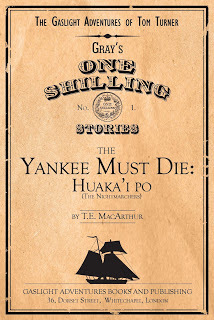 related milestone dates. And equally, we should not be surprised that our media reflects this by presenting books, TV shows, and movies that squander the opportunities offered by real history, all because some producer or publisher thinks “history is boring.” Don’t get me wrong, I’m all for historical fantasy, I write the stuff. But I like to think that I’m honest about it. I feel a responsibility to use a foundation of accuracy before altering it, just as an artist learns the methods of the masters before creating their own style. I write fantasy; I do not promise my books can replace your history texts. But that seems like a brick wall when in reality it is a very thin line.
related milestone dates. And equally, we should not be surprised that our media reflects this by presenting books, TV shows, and movies that squander the opportunities offered by real history, all because some producer or publisher thinks “history is boring.” Don’t get me wrong, I’m all for historical fantasy, I write the stuff. But I like to think that I’m honest about it. I feel a responsibility to use a foundation of accuracy before altering it, just as an artist learns the methods of the masters before creating their own style. I write fantasy; I do not promise my books can replace your history texts. But that seems like a brick wall when in reality it is a very thin line. Deep down inside, I have to wonder if we know anymore what is fact and what isn’t? Is it possible that we have fantasized our history so much that we cannot quite tell the difference? I know there are political groups trying to have history texts re-written to suit their needs, ironically because they claim all history books have been re-written to suit someone else’s needs and that’s wrong in their book. Do they have a book? Are they right?
I know that we have whitewashed history for years, especially since “history is boring” and we want to give only the basics to students before they fall asleep. Or, because they are too young, innocent, undereducated, unable to critically analyze … whatever the excuse. Talk about a Catch 22.
As much as it sounds disheartening that history is really becoming more fantasy than reality, I think there is room for hope. These days, if a reader can use Wikipedia, they expect their authors can too. And if authors don’t, readership fades. Despite years of being taught about the dullness of historical development, there seems to be a rise in interest. Granted, it’s via the fantasy route with paranormal histories, dramatized biographies, Steampunk and higher-end romances. We can thank the internet for it. The
 base of knowledge we have today is tremendous, and getting larger. Competition for viewer time, ticket sales, and book purchases means that the audience can be picky. Sure, we’re back to the fantasy vs fact which challenges the internet as much as history texts, yet I view the plethora of information as promising. It also creates a demand that we know our histories better than before, when writing a historical novel. We can’t short cut: we can’t fail to know that Augustus Caesar never checked a pocket watch for the time and Annie Oakley was a married, tea-totaling lady. Our readers can double check us, and they can punish us for failing them by not buying our work. Yes, I know, some folks simply don’t care, but I think their numbers are diminishing. Smart phones make it cool to look things up on the spot. “Geeks” are beginning to be in vogue.
base of knowledge we have today is tremendous, and getting larger. Competition for viewer time, ticket sales, and book purchases means that the audience can be picky. Sure, we’re back to the fantasy vs fact which challenges the internet as much as history texts, yet I view the plethora of information as promising. It also creates a demand that we know our histories better than before, when writing a historical novel. We can’t short cut: we can’t fail to know that Augustus Caesar never checked a pocket watch for the time and Annie Oakley was a married, tea-totaling lady. Our readers can double check us, and they can punish us for failing them by not buying our work. Yes, I know, some folks simply don’t care, but I think their numbers are diminishing. Smart phones make it cool to look things up on the spot. “Geeks” are beginning to be in vogue. I don’t have an easy answer for this – sorry, I’m going to fail you here. But I do have plenty of questions, and I hope you can see that the 600 pound gorilla needs to be recognized. Can we draw a line between fantasy and fact with honest presentation? I hope so. I plan to write historical fantasy for quite some time, but I will promise you here and now that I’ll speak up about what I’m making up and what I’m not.
Oh, and please give history a chance. Really, the silly, brilliant, annoying, frustrating, disappointing and hopeful things humans have done before are likely to be repeated – it’s best to be fully prepared and armed to discern the difference between fact and fiction. History is not boring, certainly not if we keep doing things from the past, sometimes expecting another outcome despite what we know. Or … is that the definition of insanity?
More about T.E. MacArthurT. E. MacArthur is an author, artist, and historian living in the San Francisco Bay Area with her constant companion, Mac the cat. She received her Bachelor’s degree in history from Cal State University and spent many an evening in subsequent Anthropology, Geology, Criminal Investigation and Art classes. Writing remains, however, her passion. She has written for several local and specialized publications and was even an accidental sports reporter for Reuters.
The Volcano Lady: Volumes I & II follow the adventures of Victorian lady scientist Lettie Gantry, and are T.E.'s first novels in publication.
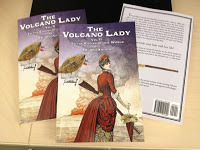
The Yankee Must Die novellas continue the thrilling adventures of Tom Turner following the time honored cliffhangers of dime novels, penny dreadfuls, and weekly serials.
To put it mildly, T.E. has a love for all things Victorian (history and clothing from 1870 – 1890 in particular) and is having a lifelong affair with the writings of Jules Verne. For fun, facts and giveaways visit http://VolcanoLady1.wordpress.com(http://blog.volcanolady.com.)
Published on October 06, 2013 20:35
October 4, 2013
The Time Traveller's Guide to Elizabethan England (part i)
You know a resource is a good one when you wish you'd written it yourself!
Published on October 04, 2013 17:42
September 25, 2013
E. C. Ambrose: Blurring the Boundaries of History, Reality and Fantasy
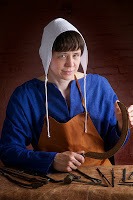
Just the other day I was discussing with some of my fantasy writing acquaintance how over time, a character I've written can become so real that find myself looking for them in the index of a book, or thinking of them as actually related to a real historical person. It can even be hard to remember, sometimes, what I've read and what I made up. Fortunately no one threatened to love me up... at the time. If they do, I can point to the wonderfully perceptive E.C. Ambrose, who will make it all make sense.

Elisha Barber, the first novel in my new Dark Apostle series, was born of reading too much history. I became interested in medieval medicine while doing some research for a scene in another book. Trouble was, the research itself was so fascinating, I couldn't leave it alone, and I kept reading—tracking down new titles to explore from the footnotes of the old, finding translations of medieval medical
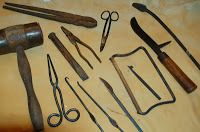 texts and indulging in detailed descriptions of operations like trepanation, amputation and "cutting for the stone."
texts and indulging in detailed descriptions of operations like trepanation, amputation and "cutting for the stone."I knew I was ready to write when all of that history brimmed over in my story space, and started spilling out images: a man, his hands dripping with blood, stood in a sunlit doorway saying, "My God, I've killed them all." Who did he kill? And why, and what would happen next? I had to write the book to find out.
But writing into history carries its own special thrills and dangers. First of all, how much history did I really want to use? I had to find a balance between creating a believable alternate reality, and leaving myself enough room to tell the story I envisioned. First thing, the historical monarchy had to go—but not far. Based on a few coincidental dates around the timing of a beautiful woman's visit to King
 Edward Longshanks, and the subsequent birth of her child after a rather hurried marriage, I found myself a new heir to the throne—all it took after that was the king's falling out with his son (reality), his proclamation of legitimacy for this woman's child (fantasy), his own illness and death (reality) and his heir's death in battle (fantasy), and my new heir seizing the throne (well, he certainly would have if he could—he was one of Edward II's special favorites and a thoroughly nasty piece of work).
Edward Longshanks, and the subsequent birth of her child after a rather hurried marriage, I found myself a new heir to the throne—all it took after that was the king's falling out with his son (reality), his proclamation of legitimacy for this woman's child (fantasy), his own illness and death (reality) and his heir's death in battle (fantasy), and my new heir seizing the throne (well, he certainly would have if he could—he was one of Edward II's special favorites and a thoroughly nasty piece of work).The twisting together of fantasy and history thus becomes more dense, hopefully blurring the boundaries until my ideas are seamlessly blended with the facts. Then there is reality itself. When you write historical fiction, you're not only constructing fantasy on the scaffold of the historical record, but building upon the foundation of a real place and time. Which is, of course, an excellent excuse to travel to England.
 While I was researching that first research jaunt, I found a flat to stay in with a view of Saint Bartholomew's Church, a location which figures in the book. St.Bart's, as it is affectionately known, was founded by Rahere, the fool and crusading companion of King Henry II. He fell ill while on pilgrimage, and made a vow to build a church and hospital if he returned safely home. And there they stand to this day, hard by Smithfield, just outside London's city wall, with the fool himself buried inside, a wonderful legacy on which to craft my fantasy.
While I was researching that first research jaunt, I found a flat to stay in with a view of Saint Bartholomew's Church, a location which figures in the book. St.Bart's, as it is affectionately known, was founded by Rahere, the fool and crusading companion of King Henry II. He fell ill while on pilgrimage, and made a vow to build a church and hospital if he returned safely home. And there they stand to this day, hard by Smithfield, just outside London's city wall, with the fool himself buried inside, a wonderful legacy on which to craft my fantasy.And when I took in the view from that flat, I thought, "Oh—there's the churchyard where Elisha's brother is buried!" Except. . .Elisha is a fictional being, an invisible friend of mine, brought to life through words alone. He has no brother, and his brother has no grave. He does not, alas, exist—not now, and not in Londonin the fourteenth century.
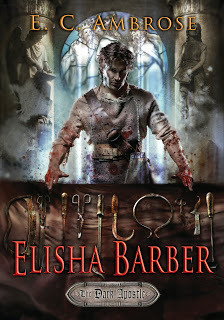 And yet. And yet, the book can now be enjoyed by readers all over the world, readers unfamiliar with the time and place of its setting, who are simply looking for a good fantasy. Perhaps my blending of history and reality will spark their curiosity, and some of them will delve further, uncovering the startling events that really lead to the downfall of Edward II, or gaining a better understanding of the history of medicine (along with a healthy dose of gratitude not to be living back then). And maybe one day soon, a reader of my fantasy will be walking a certain street in Londonand stop at the sight of the brick-and-stone church of Saint Bartholomewto think, "That's where Elisha's adventure began—I wonder where he'll go next?" And my illusion formed of fantasy and history will have taken on a reality of its own.
And yet. And yet, the book can now be enjoyed by readers all over the world, readers unfamiliar with the time and place of its setting, who are simply looking for a good fantasy. Perhaps my blending of history and reality will spark their curiosity, and some of them will delve further, uncovering the startling events that really lead to the downfall of Edward II, or gaining a better understanding of the history of medicine (along with a healthy dose of gratitude not to be living back then). And maybe one day soon, a reader of my fantasy will be walking a certain street in Londonand stop at the sight of the brick-and-stone church of Saint Bartholomewto think, "That's where Elisha's adventure began—I wonder where he'll go next?" And my illusion formed of fantasy and history will have taken on a reality of its own.
Read samples etc. from E.C. AmbroseFor sample chapters, historical research and some nifty extras, visit www.TheDarkApostle.com
For more about E.C. AmbroseE. C. Ambrose blogs about the intersections between fantasy and history at http://ecambrose.wordpress.com/
https://twitter.com/ecambrose
https://www.facebook.com/TheDarkApostle
Buy E. C. Ambrose books Indiebound: http://www.indiebound.org/book/9780756408350
Barnes & Noble: http://bit.ly/13pEciI
Amazon: http://amzn.to/13HMvG2

Published on September 25, 2013 07:00
September 18, 2013
Kathy Sharp—A Teacher’s Influence
 Long ago, Thomas Hardy made Dorset famous. The contemporary drama Broadbeach is making the county slightly more familiar to many of us. Now my Crooked Cat colleague, Kathy Sharp, adds her voice to the Dorset song.
Long ago, Thomas Hardy made Dorset famous. The contemporary drama Broadbeach is making the county slightly more familiar to many of us. Now my Crooked Cat colleague, Kathy Sharp, adds her voice to the Dorset song.
Mrs Salt was the kind of teacher who was quietly influential. Probably past retirement age, she had been drafted in to help cope with the great influx of post-war baby boom children in 1950s Britain. The school was full to bursting, and classes were farmed out all over the town, wherever space could be found. My year with Mrs Salt was spent in the unlikely surroundings of a church retreat house, which had a small classroom built out into its beautiful gardens.
She kept forty of us in order without ever raising her voice. There was no caning, no loss of temper, no yelling. If you were guilty of some misdemeanor, she would simply take you aside and murmur, ‘You, of all people. I’m so disappointed in you.’ She looked genuinely unhappy, and the burden of her disappointment was enough to keep us on the straight and narrow. That and the fact that we all loved her.
Each morning, we attended assembly in the crowded main school, and then walked in pairs the half
 mile to our classroom, with Mrs Salt, in one of her elaborate hats, leading the way. We could talk, but not shout; skip, but not run. It was a residential district, and it was impressed upon us that we must not disturb people with racketing about. She managed this without squashing the natural exuberance of childhood out of us. She was a quite remarkable person.
mile to our classroom, with Mrs Salt, in one of her elaborate hats, leading the way. We could talk, but not shout; skip, but not run. It was a residential district, and it was impressed upon us that we must not disturb people with racketing about. She managed this without squashing the natural exuberance of childhood out of us. She was a quite remarkable person.The schoolroom was hung with charming proverbs: ‘There is nothing nicer than a good, careful child’; ‘If you have two loaves, sell one and buy a lily.’ As a compulsive reader, even then, I read them so many times over they are still in my head today. And I have my exercise books, complete with Mrs Salt’s comment ‘Good sentences’ written over one of my compositions.
But for me, as a writer, her finest gift was also the most enjoyable. The last half-hour of each school day was story time, and Mrs Salt didn’t waste it on any old rubbish. We had the stories of Greek myth — sea monsters, flying horses and all. Her wonderful retelling of these exciting tales had the whole class entranced, and clamouring for the story of Perseus and Andromeda, or Pegasus the winged horse. The excitement and absorption of hearing those stories, and of their becoming familiar, is still with me, and informs my fiction writing to this day.
When I wrote my novel Isle of Larus, those tales were in the back of my mind, and readers have pointed out its ‘mythical’ feel. Well, I know just where that came from: thank you, Mrs Salt.
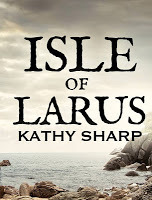 More about Kathy SharpGrowing up by the sea in Kent, back in the 1960s, it was Kathy's ambition to become a writer. Time passed. She married, moved to west London, and had a daughter. She continued to write, and had a small book or two on countryside and nature subjects published. She worked for many years as a desktop publisher for Surrey County Council, and as a tutor in adult education.And then, one day, she visited a friend who had just moved to the Isle of Portland, Dorset, and fell in love with the place. She has now lived in the Weymouth and Portland area for eight years, and still loves it. The wonderful Jurassic Coast, and Portland in particular, were the inspiration for her first novel,
Isle of Larus
.Kathy also sings with, and writes lyrics for, the Island Voices Choir on Portland, and is a keen member of local writing groups, as well as enjoying studying the local flora.
More about Kathy SharpGrowing up by the sea in Kent, back in the 1960s, it was Kathy's ambition to become a writer. Time passed. She married, moved to west London, and had a daughter. She continued to write, and had a small book or two on countryside and nature subjects published. She worked for many years as a desktop publisher for Surrey County Council, and as a tutor in adult education.And then, one day, she visited a friend who had just moved to the Isle of Portland, Dorset, and fell in love with the place. She has now lived in the Weymouth and Portland area for eight years, and still loves it. The wonderful Jurassic Coast, and Portland in particular, were the inspiration for her first novel,
Isle of Larus
.Kathy also sings with, and writes lyrics for, the Island Voices Choir on Portland, and is a keen member of local writing groups, as well as enjoying studying the local flora.
More from Kathy Sharp Isle of Larus is published by Crooked Cat Publishing and is available in paperback or e-book format
at Amazon.co.uk: http://www.amazon.co.uk/Isle-Larus-Kathy-Sharp/dp/1909841056and Amazon.com http://www.amazon.com/Isle-of-Larus-ebook/dp/B00E401AU6
You can also read Kathy’s regular Monday blog on Goodreads:
Or find her on Facebook:

Published on September 18, 2013 02:56
September 11, 2013
Beth Barany: Inspired by Gargoyles
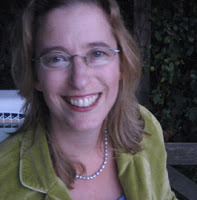 I've been looking forward to this blog for weeks! Gargoyles! Nobody does gargoyles! What a fantastic idea! While I'm busy with mermaids, here's Beth Barany and her partners with a trio of romantic fantasies and a really different focus.
I've been looking forward to this blog for weeks! Gargoyles! Nobody does gargoyles! What a fantastic idea! While I'm busy with mermaids, here's Beth Barany and her partners with a trio of romantic fantasies and a really different focus. 
My love of time travel, France, and gargoyles combined recently into a fun anthology project called Gargoyle: Three Enchanting Romance Novellas by me and two other awesome writers, my critique partners, Kay Keppler and Patricia Simpson.
Here’s how our collection of three stories came about. Sort of. I’ve always been fascinated by the medieval cathedrals of France. I love everything about them: the flying buttresses, the stone work, the rose window that lets in the south or western sun; and of course the gargoyles. Granted most of them are hard to see from the ground, and I have to admit I haven’t climbed to the top of my most favorite cathedral of all, the Notre Dame of Paris. (Embarrassing, I know!) But it wasn’t until I stumbled upon a gargoyle within reach—only ten or twelve feet above me—that I realized I wanted to write a story about them. On a whim. The way story ideas sneak up on me.
There I was circling this strange looking cathedral in the small French town of Beauvais, north of
 Paris. I was stunned to see a white-stoned gargoyle perched on the edge of a short building butted up against Beauvais’s medieval cathedral. In my research for my story I never did discover the purpose of the little building. I mean, who puts a gargoyle on the edge of a building and who creates a gargoyle that stands upright with no water spout? I discovered in my research that this type of gargoyle—with no water spout—is called a grotesque. I also discovered in the research for my novella, “Touchstone of Love” in
Gargoyle: Three Enchanting Romance Novellas
that in the Middle Ages, creating gargoyles and other creatures for the cathedrals was honored work.
Paris. I was stunned to see a white-stoned gargoyle perched on the edge of a short building butted up against Beauvais’s medieval cathedral. In my research for my story I never did discover the purpose of the little building. I mean, who puts a gargoyle on the edge of a building and who creates a gargoyle that stands upright with no water spout? I discovered in my research that this type of gargoyle—with no water spout—is called a grotesque. I also discovered in the research for my novella, “Touchstone of Love” in
Gargoyle: Three Enchanting Romance Novellas
that in the Middle Ages, creating gargoyles and other creatures for the cathedrals was honored work.I was actually more interested in who made the cathedrals and how, including the stone work, than I was in the myths and background of the gargoyle. Whereas Patricia Simpson uncovered the origin tale of gargoyle and wrote a romance retelling of that in her novella, and Kay Keppler wrote a fun end and beginning of a love story from the perspective of a modern-day garden gargoyle connected to the Roman gods Venus and Mars in hers, I had my heroine fall back in time to thirteenth century France. She gets stranded in the Middle Ages and is essentially rescued by Julien, a stone mason. In my story I explore what it must have been like to work for the honor of becoming a Master Mason. My hero Julien strives for this with his special gargoyle, the touchstone of love around which my story circles.
A few other discoveries I made when researching my story: Materials for cathedral building and other stone work was limestone, at least for the cathedral of Beauvais; also the materials for creating a gargoyle are quite simple. A stone worker would only need a chisel and a mallet. We modern folk can only speculate, but people think that gargoyles were created on gothic cathedrals to scare evil spirits away, bring in the pagan believers, and did have the water spout function, to keep water off the walls of the cathedrals.
I was so inspired by the white-stoned gargoyle I saw in that small town in France that I posted a picture of on Facebook and asked if anyone had written a story about a gargoyle. My friends suggested I do it. So here we are.

The BooksAbout GARGOYLE: THREE ROMANCE NOVELLASThe mysterious lives of gargoyles. They don’t just hang out on buildings. They right wrongs. They wreak havoc. And they change the lives of unsuspecting people who never see them coming.
ON A WING AND A PRAYER BY Kay Keppler (Humorous Contemporary)
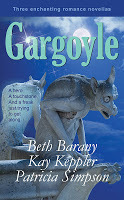 The hero...Craig knows that Bea is in trouble. But Craig can’t do anything about it—because he’s a garden gargoyle and Bea can’t hear his warnings. When unexpected visitors arrive to help, Craig finds the power he had all along. Now the neighborhood will never be the same.
The hero...Craig knows that Bea is in trouble. But Craig can’t do anything about it—because he’s a garden gargoyle and Bea can’t hear his warnings. When unexpected visitors arrive to help, Craig finds the power he had all along. Now the neighborhood will never be the same.TOUCHSTONE OF LOVE by Beth Barany (Time Travel)The touchstone...When a thunderstorm transports software expert Rose Waldman to thirteenth century France, she meets hunky stonemason Julien, who is secretly creating a gargoyle in defiance of his master mason. Can independent gadget loving Rose trust her life and heart to Julien, and can she really never go home again?
THE MILLER’S DAUGHTER BY Patricia Simpson (Historical)And the freak just trying to get along...Sentenced to burn at the stake for sorcery, Merofled volunteers to help jaded warrior Alaric kill a gargoyle that threatens her village. But Merofled soon discovers the gargoyle is not a monster at all. It’s a misfit just like her. Can she persuade Alaric to spare the gargoyle–and herself?
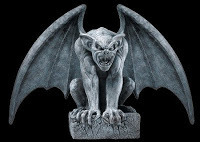 Excerpt from “TOUCHSTONE OF LOVE” by Beth BarabnyJulien of Beauvais stomped through the edge of town, through the fields and the stormy dark. He didn’t care about the wet and wind. He needed to find peace, he needed to find inspiration. It was time that he showed Master Stonemason Bernard de Chantilly all of his skill and artistry and present his master work to the community and get his approval, even if the master stonemason said Julien could not present his work at Michaelmas in five days.
Excerpt from “TOUCHSTONE OF LOVE” by Beth BarabnyJulien of Beauvais stomped through the edge of town, through the fields and the stormy dark. He didn’t care about the wet and wind. He needed to find peace, he needed to find inspiration. It was time that he showed Master Stonemason Bernard de Chantilly all of his skill and artistry and present his master work to the community and get his approval, even if the master stonemason said Julien could not present his work at Michaelmas in five days.The master stonemason didn’t like him and had not allowed him to present the previous year. But this year would be his. It was time he showed Master Bernard that he was ready to become a master mason and travel as a free man. His training was complete. He’d become a journeyman and done a short trip to Paris with Master Bernard a few years ago. Yet, most men at his age of twenty-six years had already started their own houses and were busy at work on the new cathedrals sprouting all over France.
He wanted to travel to Amiens, or Rennes, and direct his own house, with a woman at his side, and his own apprentices, and a passel of children. The time was now. His time. Oblivious to the cold and the wet, Julien stomped through the field in anger.
Not only was Master Stonemason Bernard a barrier to his dreams, but so was also Marie-Jeanne, his intended. She’d betrayed him with that farm boy from the count’s household. How was he going to create a home when his betrothed was ready to run off with another?
That was why, in his anger, he’d messed up the day’s stone carving work and had been relegated to sorting and breaking granite blocks for the other apprentices.
The rain pelted his face as Julien stumbled over something. He lost his footing and slipped to his knees. He put out his hands to brace himself and felt something soft. Soft and warm.
As gently as he could, as if he were handling a new-born lamb back at his parents’ farm, he felt for the shape of the soft and warm, and unmistakably touched a breast. A woman fallen in the fields. In the cloudy night with no light of the moon or stars, he reached out to learn more about her. She was alive by the warmth of her, and by the strong pulse at her throat, and not long outdoors, as her skin wasn’t completely chilled. He couldn’t leave her, so he scooped up her unconscious, naked form and headed for his workshop hidden in a copse of chestnut trees outside the walls of the town.
Once inside his small workshop, he stoked the fire under the cook pot. He rushed to cover her with his blanket and rubbed the hands and feet of the woman, something he’d seen the old midwife do to women who sometimes fainted in the fields. The woman breathed deeply, but remained asleep.
She was naked, curved in all the right places. Clearly well fed, luscious, but quite improperly dressed for a fall night, as if she’d been bathing and wandered off from her task.
Maybe she was under some spell that made her sleep. While he was a god-fearing man, and worshiped Mother Mary, he knew magic was in the land. He felt it when he worked the stone every day, but never talked about it.
The woman appeared calm, even peaceful as she slept. Definitely a woman, not a girl. Her long golden locks had come loose from her tie. She had rosy cheeks, pink lips, an angular nose, and a long column of a throat. Her chest rose and fell with even breaths.
What color were her eyes? He pulled the wool blanket up under her chin, and tucked it around her body to keep her warm. A tiny waist, a warm shapely rump, long legs, strong feet—he noticed all that as he chastely tucked the blanket around her. He’d noticed that her palms were strong, with callused, long fingers, almost as big as his. She must be a farmhand from a neighboring village, but he didn’t recognize her.
She was almost angelic in how she slept. His troubles forgotten, he made for his worktable on the other side of the one-room shed and picked up his chisel.
He’d found the inspiration he needed to start his work of art.
For more, please go to Amazon: http://viewbook.at/Gargoyle
About Beth BaranyAward-winning author, Beth Barany has been making up fantasy and adventure stories all her life. She writes magical tales of romance and adventure for women and girls to transport them to new worlds where anything is possible. To learn more about Beth and her fiction, visit her site: http://author.bethbarany.com .
Published on September 11, 2013 10:38
September 4, 2013
Adam S. Leslie: A Writer Interview
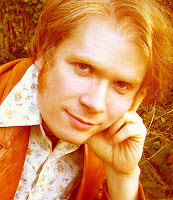 One of the newest kittens in the cat's cradle that is my esteemed publisher, Crooked Cat Publications, is my colleague British author Adam S. Leslie. He's generously agreed to sit down to an interview or me this week. The focus, all those little things you want to know about about an author you've just met. And of course, the reason you've met him... his new novel, Kaleidoscope.
One of the newest kittens in the cat's cradle that is my esteemed publisher, Crooked Cat Publications, is my colleague British author Adam S. Leslie. He's generously agreed to sit down to an interview or me this week. The focus, all those little things you want to know about about an author you've just met. And of course, the reason you've met him... his new novel, Kaleidoscope.
So Adam, when did you decide to become a writer?
I’d already been writing fiction since I was about 11 when I collaborated with my school friend Peter (still my semi-regular co-author) on a Tolkien-inspired adventure story he’d started, and I just sort of slotted naturally into writing every day. I’d take time off school just so I could write – it was somewhere to escape from my soul-destroying all-boys grammar school reality. But I’ve never been one to think too far into the future, and it was only when I was 18, and people began demanding I make some life choices, that it really occurred to me, “I don’t want to do anything else.”
Why do you write?
I almost take it for granted now. It’s probably deeply unhealthy that I am what I do, that my identity is so totally intertwined with my creativity. I was chatting to the author Ki Longfellow about this the other day – I was quite envious that she’d recently had the epiphany, “I’m Ki, who also happens to write”. I haven’t reached that stage yet, my happiness is still wrapped up with my creativity. When it’s going well, though, it’s the most magical thing, which makes it all worthwhile.
Do you write every day?
Pretty much. I have to force myself to take a day off, and then I feel bad about it. I write films as well as novels, so that takes up nearly all my time. I hate doing nothing.
What is the hardest thing for you about writing?
Most people seem to say the loneliness, but I rather like it. For me, the toughest part is generating the initial story. I’ll usually start with the seed of either a mood, an atmosphere or a texture that I want the book to exist within, and build the story up from there. So, at the start, Kaleidoscope is a bright, plastic, commercialised dystopia full of robots and phobic people on the verge of mental collapse. That was my starting point. The hard part was then finding the right plot to bring this to life. I’m so easily distracted when I’m not physically writing!
What do you find the easiest thing about writing?
When you’ve hit a seam of inspiration and the book writes itself. There’ve been a few occasions when I’ve written perhaps 50 pages in just two or three days, barely had to think about it, and it’s always among my best work. I love being able to let go of my self-critical faculties and just let the inspiration play itself out. One really fantastic idea can set the ball rolling, but that ‘perfect wave’ doesn’t come along very often.
Tell us about the cover and how it came about.
The cover is a painting by talented American artist and writer, Evelyn Mars Siple. Mars is her real middle
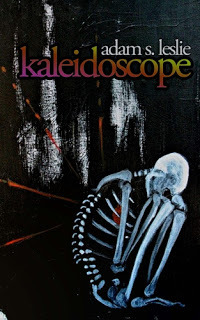 name! The picture existed separately from the book, but – along with the rainbow-coloured lettering – it perfectly fitted the mood, and I was very grateful that she let me use it. Now I can’t imagine Kaleidoscope without it.
name! The picture existed separately from the book, but – along with the rainbow-coloured lettering – it perfectly fitted the mood, and I was very grateful that she let me use it. Now I can’t imagine Kaleidoscope without it.All this writing sounds like work! How do you relax?
I’ll come back to you when I’ve figured that out! I’m a bit of a workaholic, I must admit. I spend all day writing fiction, so I struggle to relax with a good book – although I do enjoy factual writing. There’s a Harry Nilsson biography out at the moment that I’ve got my eye on.
I’ve also been enjoying archive TV lately, especially shows from my childhood. Mysterious Cities of Gold still stands up well, and the adaptation of Helen Cresswell’s novel Moondial (which was filmed in Lincolnshire near to where I grew up) is worth three hours of anyone’s time. Those old production values, the grainy film stock and U-matic video, have developed a magic all their own over the intervening years. Nothing else quite looks or feels like '70s/'80s British TV.
Which famous person, living or dead would you like to meet and why?
There are a ton – from the super-famous to internet bloggers; and in each case because they seem like interesting people rather than because they’re famous. I’ve met Paul McCartney, but I’d love to sit down for a proper chat; and Steven Spielberg, both have worked at the very top of their field, they have so much passion and can talk so articulately.
I think that’s the thing… I don’t want to talk to people about what they do, but about our shared passions. I could shoot the breeze for hours with They Might Be Giants or director Edgar Wright. Ellen Page seems to be interested in talking about her principals and cool bands more than the whole Hollywood thing, which would be refreshing. I’d love to chat with film reviewer and heroic grump, Mark Kermode. I’ve just started watching internet blogger Lindsay Ellis’s fun pop culture reviews, and there’s that sense of “here’s an enjoyable person to spend a movie night with”. Michael Steele from The Bangles, someone else who is articulate and passionate about music as a whole. But there are so many.
On the other end of the spectrum, there are those larger-than-life heroes who are no longer around – it’d be interesting to see if we would’ve got along, or if I’d have been totally intimidated by them: Philip K Dick, Stanley Kubrick, Vivian Stanshall, Delia Derbyshire, Spike Milligan, John Lennon, Steve Marriott. I’d probably be too scared to speak!
Finally, and always my favorite question: When you come to power what’s the first thing you’ll do?
I'd have celebratory cocktails, get slightly drunk, say some mystifying things to the press, then go to bed for a snooze. I'm not a man with a plan.

Meet Adam S. LeslieAdam S. Leslie is a novelist, screenwriter, musician and singer-songwriter. He also once spent a morning as a stuntman on a major Hollywood movie, but his scene was deleted.
Covering a broad range of styles, his native genres include magical realism, conceptual science fiction, puzzle-box thriller, satire, experimental, surrealist comedy and the occasional foray into the spookier end of horror.
His first novel, Kaleidoscope, was published by Crooked Cat in August 2013.
Adam likes cocktails, cakes, old records, racing cars, the Marx Brothers and snails (but not to eat).
Find Adam on the web at http://adamlesli3.wix.com/aslwriter

About KaleidoscopePeter Tobey lives an idyllic existence of energy drinks, mindless television sitcoms, phobia-induced hypersensitivity – and shopping. Into his world comes Kaleidoscope, a sinister and addictive sitcom which turns bright, happy shoppers into lethargic drones. Peter realises that he and his small group of friends must make the ultimate sacrifice: end Kaleidoscope, flee their beloved shopping centre, and be the first people in generations to step Outside and into the great unknown...
Kaleidoscope is a pulsating, kaleidoscopic blend of magical realism, dystopian fantasy-adventure, satire, trash culture, science fiction, post-modern horror, and the childhood fever in which you and your family have been trapped for the last thirty years.

And here's an ExcerptThe endless passages reminded Magenta of something from her past, something aching and empty from long ago before she was an adult. She’d been prone to fevers as a child, afternoons unfurling one after the other like a sequence of blank grey banners, each merging into the next, grey and identical and dreary. No, dreary was the wrong word. Awful. Awful days overlapping into a single long afternoon that lasted for weeks, body aching with the strain of just being, head feeling as big as the whole bed yet smaller than a golf ball. The knots in her favourite comfort blanket swelling up to swallow her, but far too small for her hands to grip because her hands were far too small to grip them. The picture at the foot of her bed – a parade of teddy bears holding a goose aloft on their shoulders – bobbing about in front of her eyes, right up by her face, close enough to touch; yet simultaneously almost too far away to see. Close up and…Far away…And…
The Chaps.
She hadn’t thought of The Chaps in years. She’d have been about three or four, lying in bed, watching the bars of her younger brother’s cot judder in a dance of sickening double-takes, solid objects flinching as if taken by surprise. She was ill with a high fever, though at the time she hadn’t realised. She’d given it a name, this jerking of inanimate things. The Chaps. How she’d come up with a name so expressive as a three-year-old she didn’t know, but she could still remember, over twenty years ago, thinking to herself, I’ve got The Chaps tonight.And now here she was in the Outer Zones, back inside the delirium of childhood, surrounded on all sides by The Chaps, Shoutie, Screamers, Vomiter, Sore Bones and the one about eyes being close and far away... each one a symptom of that delirium.Robbie had mentioned other names from the map. Smallfist was one. Spider, Flux, Void, Hurter, Speckles, Mothertone. Smallfist tallied with childhood fever: fists too small to grip, so small she could barely squeeze them shut. Seeing spiders that weren’t there. The impression that the world was fluctuating around you. The void inside and the void all around. Your whole body hurting. Speckles flashing in front of your eyes. Your mother’s voice calling your name, endlessly calling, but wrong somehow, the wrong tone, too deep or too high or just too damn persistent to be real. Magenta.Magenta.Magenta, dear.Magenta.Oh, Magenta.
Leave me alone!!
Published on September 04, 2013 02:37



